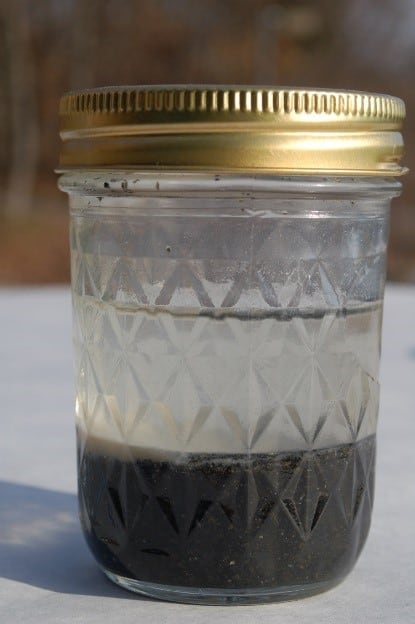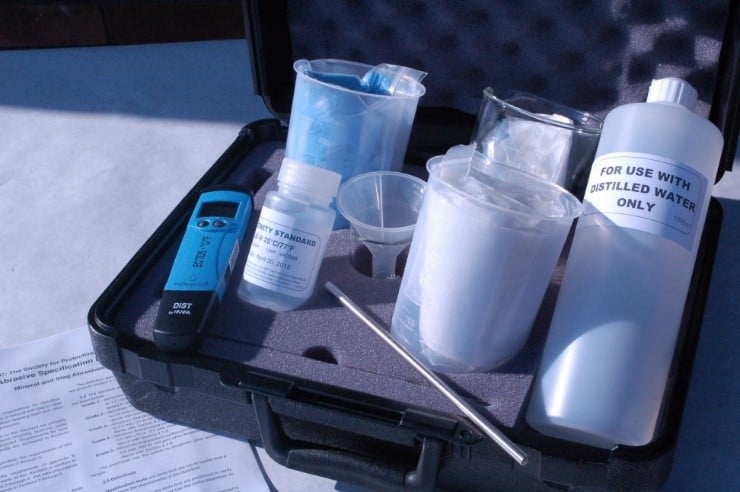Proper surface preparation is one of the most critical steps towards maximizing the life of a coating system. If coatings are applied to improperly prepared surfaces, the system is much more likely to fail prematurely. Abrasive blast cleaning is the most common and productive form of surface preparation. Abrasive selection is a key component to an abrasive blast system. Selection of the type and size abrasive is dependent on the degree of cleanliness specified, the depth of the surface profile, the type of substrate to be prepared, and any specification requirements regarding type (e.g., use of expendable verses recyclable abrasive). The cleanliness of the abrasive (whether new or recycled) is equally important. Oil and/or salt contamination on an abrasive may be transferred to the surface during blast cleaning operations and adversely affect long term coating performance.
There are many factors that impact quality and productivity during abrasive blast cleaning operations, but the abrasive quality is critical for long-term performance of the applied coating system. The degree of embedment from abrasive blast cleaning operations can vary widely even within a generic category of abrasive. Abrasive embedment is inevitable and is not normally detrimental, but if the abrasive is contaminated, so is the embedment.
Oil transferred to the substrate can cause film defects (e.g., fish eyes) and potentially affect adhesion of the primer. Water soluble salts transferred to the surface can cause accelerated rust back, osmotic blistering, under-film corrosion, and premature coating failure. Without routine monitoring of abrasive cleanliness, these contaminants could go unnoticed.
What if the Project Specification Doesn’t Address Abrasive Cleanliness?
Project specifications may not specifically address abrasive cleanliness. However, many will invoke one of more of the SSPC abrasive blast cleaning standards (e.g., SSPC-SP 10 Near-white Metal Blast Cleaning; SSPC-SP 6 Commercial Blast Cleaning, etc.). The abrasive blast cleaning standards are composed of both direct and indirect requirements. The “direct” requirement is the degree of cleaning; for example, SSPC-SP 10 permits a maximum of 5% staining. There are several indirect requirements, including:
- Removal of grease/oil contamination prior to blast cleaning, per SSPC-SP 1
- Compressed air cleanliness tested in accordance with ASTM D4285
- Abrasive cleanliness, per the SSPC Abrasive (AB) Standards
An excerpt from one of the SSPC abrasive blast cleaning standards addressing abrasive cleanliness is shown below:
So even if the project specification does not specifically address abrasive cleanliness, it is automatically invoked when an SSPC abrasive blast cleaning standard is specified. That is, abrasive cleanliness is an indirect requirement.
How can I tell if the abrasive is contaminated?
Abrasive manufacturers may have performed laboratory analysis of the product, but this does not satisfy the requirements of SSPC abrasive standards. More importantly, it does not reveal the current condition of the abrasive. Transporting, storing, and recycling of the media can affect the cleanliness of the abrasive. The two tests that are used to verify abrasive cleanliness are oil content and water soluble salt content. The contractor’s quality control inspector typically performs these tests.
 Oil contamination is determined in accordance with ASTM D7393, Standard Practice for Indicating Oil in Abrasives. This field test, commonly known as the vial test, requires that a sample of abrasive be placed in a clean, sealable container. Tap water is added to the container so that it is approximately 1 inch above the abrasive. The container is shaken for about 1 minute and allowed to stand up to 5 minutes. The surface of the water is then visually examined for any oil droplets or sheen. If oil is visually evident, the abrasive fails the test. This test should be conducted at least once per shift (during blast cleaning operations) and at least 3 tests per shipment of bulk delivery. This test also reveals whether the abrasive is excessively dirty. If dust settles on the surface or water remains cloudy, the overall cleanliness of the abrasive should be questioned as this could cause impede production.
Oil contamination is determined in accordance with ASTM D7393, Standard Practice for Indicating Oil in Abrasives. This field test, commonly known as the vial test, requires that a sample of abrasive be placed in a clean, sealable container. Tap water is added to the container so that it is approximately 1 inch above the abrasive. The container is shaken for about 1 minute and allowed to stand up to 5 minutes. The surface of the water is then visually examined for any oil droplets or sheen. If oil is visually evident, the abrasive fails the test. This test should be conducted at least once per shift (during blast cleaning operations) and at least 3 tests per shipment of bulk delivery. This test also reveals whether the abrasive is excessively dirty. If dust settles on the surface or water remains cloudy, the overall cleanliness of the abrasive should be questioned as this could cause impede production.
Water soluble contaminants are the non-visible soluble salts that may be present on an abrasive. The abrasive is tested in accordance with ASTM D4940, Standard Test Method for Conductimetric Analysis of Water Soluble Ionic Contamination of Blast Cleaning Abrasives. According to the SSPC AB standards the conductivity of the abrasive cannot exceed 1,000 µS/cm (micro-siemens/cm).
 This field test takes equal parts abrasive and deionized water (300 mL of each) that are combined and are twice stirred for 1-minute (with an 8-minute standing time between stirs) to leach any soluble salts from the abrasive. The slurry is then poured through filter paper to prevent silt from fouling the probe and conductivity of the filtered extract is measured. It is important that the conductivity meter compensate for temperature and that the probe is verified for accuracy using a controlled solution with a known conductivity value prior to use.
This field test takes equal parts abrasive and deionized water (300 mL of each) that are combined and are twice stirred for 1-minute (with an 8-minute standing time between stirs) to leach any soluble salts from the abrasive. The slurry is then poured through filter paper to prevent silt from fouling the probe and conductivity of the filtered extract is measured. It is important that the conductivity meter compensate for temperature and that the probe is verified for accuracy using a controlled solution with a known conductivity value prior to use.
Which abrasive cleanliness standard should be used?
There are four SSPC Abrasive standards:
- SSPC-AB 1: Mineral and Slag Abrasives
- SSPC-AB 2: Cleanliness of Recycled Ferrous Metallic Abrasives
- SSPC-AB 3: Ferrous Metallic Abrasive
- SSPC-AB 4: Recyclable Encapsulated Abrasive Media
Each standard has different requirements based on the type of media but are identical when it comes to the quality control tests for oil content and water-soluble contaminants. SSPC-AB 2 requires additional field and laboratory tests for cleanliness to help ensure the abrasive recycling equipment is functioning properly and that the abrasive operating mix is still adequately sized. SSPC-AB 4 requires more frequent testing including at least three water-soluble contaminants tests at different times during an 8-hour period.






It is a good practice to follow a step similar to “Procedure Qualification Test “of the blasting team on test plate. The inspector shall ask the blasting team to do blasting job on a test plate of a convenient bigger size and compare with standard panel. The test shall be repeated till the team is capable of carrying out the desired blasting job. This of course does not exclude regular inspection during actual job.
Gurudas, the following is a reply from the author, John Todd:
Although it may not be required by the specification, it is good practice to first conduct a test panel to confirm the planned method of surface preparation will meet the specification. This allows the contractor, inspector, and owner to identify any potential issues with the method before it becomes a larger, more costly problem. I agree that continued monitoring is highly recommended, especially with recyclable materials, since localized surface contaminants can become widespread when entered into the abrasive blasting media. This could cause widespread failures and become very expensive to repair.
Hi John,
I’m a little confused – can you please help !
ASTM D 4940 NOTE 1 says ” …. high level of contamination is 500µmho/cm” . As per conversion given in the standard on Page 2, this would equal 50mS/m or 500µS/cm. Yet SSPC AB-1 says < 1,000µS/cm is acceptable.
Regards
The following is from the author, John Todd:
Thank you for your question Mr. Mann. The note in the ASTM D 4940 test method was used as an example to demonstrate that the higher the number, the more contaminated the abrasive. It was removed from the test method in the 2015 revision as it does create confusion as you mentioned.
The current ASTM D 4940 – 15E1 replaced Note 1 with section 4.3 that reads, “Abrasive standards published by SSPC (AB) and ISO 11126 provide tolerance levels for water soluble contaminants of the abrasive.” This more clearly refers the reader to SSPC or ISO standard for testing acceptance criteria.
Great article as usual John / KTA!
Many thanks.
For a very simple coating site as I understand the conductometric test as per ASTM D4940 would be … 300 ml abrasives + 300 ml water of ‘known’ conductivity; then 1 minute stirring – 8 minutes stand by – 1 minute stirring, then filtration and take the conductometric reading of the extract in µS/cm. It has to be less than 1000 µS/cm as per SSPC AB.
Is there any corelation – for practical guidence – between the soluble impurities content (“salt level”) in the abrasive sample and the resultant “salt level” of the substrate after blast cleaning with that abrasive media?
As I remember, in Water Ballast Tanks’ painting, we used to ensure the extract value should be less than 300 µS/cm while our target was ‘below 50 mg/sqm’ (or 500 µgm/sqcm). We never had a big problem. Occasionally if the steel substrate was abused, we used to get reading beyond 50 mg/sqm.
It’ll be great if any rough estimate of range of the resultant values can be suggested. At least from our experiences.
Kaunteya, the following is a response from the author, John Todd:
Thank you for the question. I do not think anyone can confidently quantify abrasive contamination transfer to a surface during abrasive blast cleaning, as there are too many variables to consider. Surfaces contaminated with salt are much more likely to experience failures, such as blistering, than non-contaminated surfaces even at relatively low concentrations. This is especially true for coatings in a marine service environment or immersion, such as ballast tanks. Because small amounts of soluble salts can result in premature failure, owners may error on the side of caution and require more stringent acceptance criteria (such as 300 µS/cm in your example) than the recommendation given in SSPC abrasive standards.
Thank you!
Not checking the abrasives conductivity, and seeing only the coatable substrate’s conductivity after surface prepn is too dangerous.
Setting the abrasives’ acceptable conductivity value too low may be too strict.
And for some standards, the SSPC’s number of 1000 µS/cm may be too lenient!
So, best way is, to keep it below 1000 µS/cm as low as possible – till the contractor allows and maintain.
The substrate conductivity values after the surface prepn must be ensured under specified limit for specified checking frequency anyway!
How can I measure the abrasive turbidity. What is the unit?